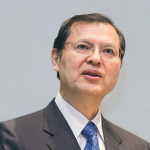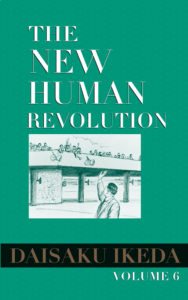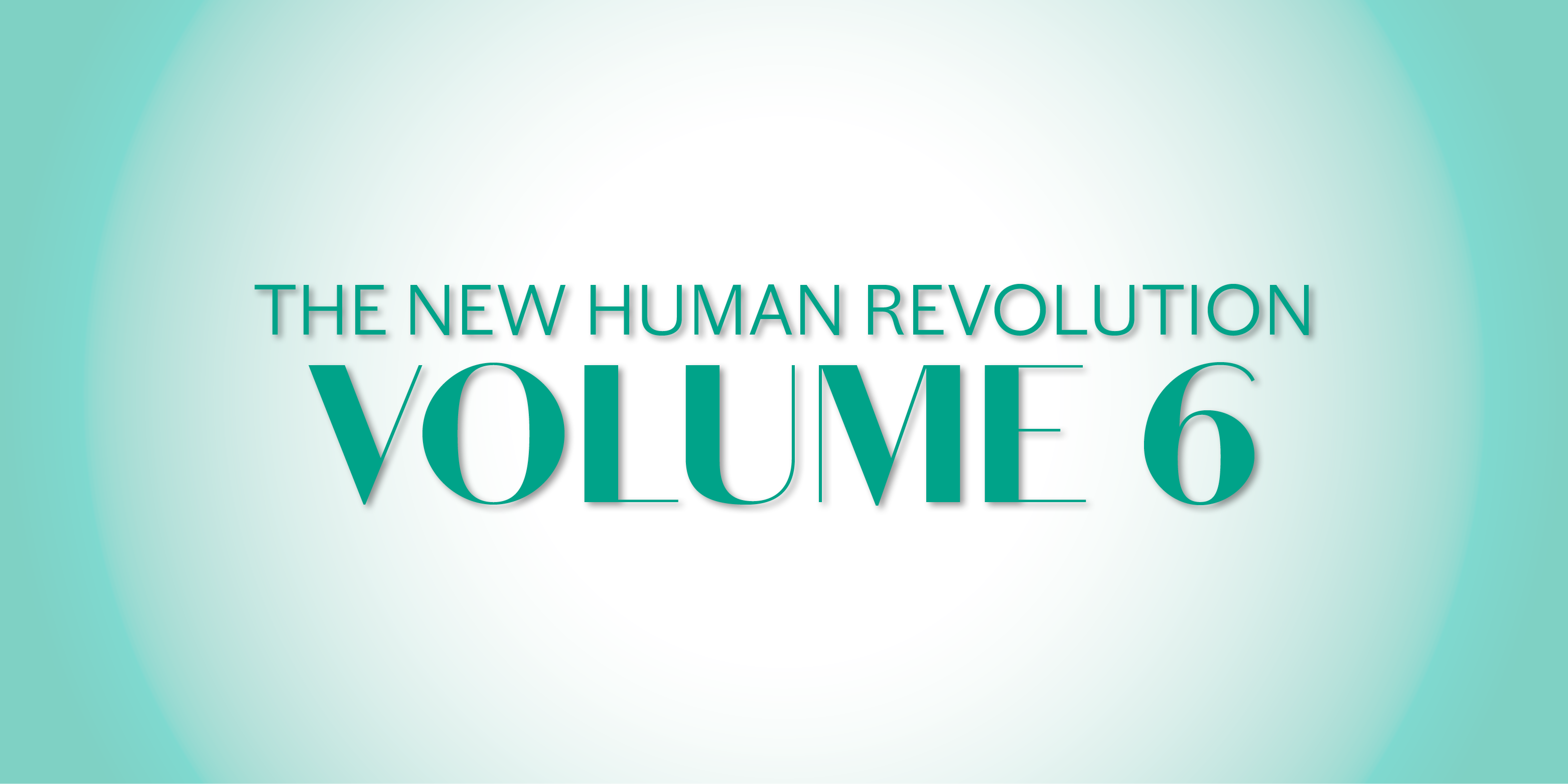 The first two chapters of volume 6, “Treasure Land” and “Long Journey,” detail Shin’ichi Yamamoto’s travels to seven countries—Iran, Iraq, Turkey, Greece, Egypt, Pakistan and Thailand—between January and February 1962. One of the objectives of the trip is to observe the religious conditions in these countries. I believe it was extremely important for Shin’ichi to explore firsthand the culture and history of Islam, whose birthplace was the Middle East, in the process of outlining his vision for worldwide kosen-rufu.
The first two chapters of volume 6, “Treasure Land” and “Long Journey,” detail Shin’ichi Yamamoto’s travels to seven countries—Iran, Iraq, Turkey, Greece, Egypt, Pakistan and Thailand—between January and February 1962. One of the objectives of the trip is to observe the religious conditions in these countries. I believe it was extremely important for Shin’ichi to explore firsthand the culture and history of Islam, whose birthplace was the Middle East, in the process of outlining his vision for worldwide kosen-rufu.
On January 30, Shin’ichi arrives in Tehran, Iran, marking his first steps in the Middle East with the determination to open a path toward lasting peace and harmonious coexistence among all people through the power of the human spirit. While aware that this would be a long and arduous journey, he is convinced that it is the road he must travel to fulfill his mission. The “Long Journey” chapter concludes with the following reflection:
Because [kosen-rufu] was such a long journey, each and every step along the way was tremendously important—it was crucial to keep the flames of unflagging courage and conviction burning, no matter what happened.[1]
Let us all engrave these words in our hearts as we strive to advance worldwide kosen-rufu.
In the Middle East, Shin’ichi discusses the importance of promoting intercultural understanding and dialogue across civilizations. One of the youth leaders comments that he thinks Islam is quite uncompromising regarding the supremacy and absolute infallibility of its God, and suggests it might be difficult to promote interfaith dialogue with Muslims.
To this, Shin’ichi responds that the answer might be to start by focusing the discussion on the problems we all share as human beings. He recalls second Soka Gakkai President Josei Toda’s words:
A common understanding would be quickly achieved if the original teachers of the major religions—Nichiren Daishonin, Shakyamuni, Jesus Christ and Muhammad—all got together in one room and held a conference.[2]
He then comments:
The only solution is for the different groups’ believers today to return to the spirit of these religious teachers—who devoted their lives to the people’s salvation—and talk with one another from that standpoint.[3]
In other words, engaging in dialogue based on mutual respect for our common humanity is vital in deepening intercultural understanding.
During his time in Egypt, Shin’ichi makes the acquaintance of a young academic, and they exchange views on the nature of civilization. When asked about whether he thinks there is a common cause for the eventual decline of highly developed ancient civilizations, Shin’ichi states his opinion that although there were individual factors in each case, ultimately the causes of a state’s decline could invariably be found within the hearts of its people. Indeed, the human will has a powerful role to play in shaping and influencing the undercurrents of history. When viewed in this light, history is “no longer only the story of past events—it is a road sign showing the direction we should take in the present and the future.”[4]
The Drama of Revitalization
The year 1962 was a time of accelerating propagation efforts by Soka Gakkai members.
In a section of Fukuoka City, there was a shantytown known to locals as Dokan, named after abandoned earthen drainage pipes. People who were homeless or unemployed as a result of the war had settled there, making the pipes their home. The “Acceleration” chapter details how these individuals who had been marginalized and cast aside by mainstream Japanese society begin to transform their lives through practicing Nichiren Buddhism. Though many of the Dokan residents suffer from financial, health and other hardships, embracing faith in Buddhism provides them with the light of hope and courage to go on living. They experience a variety of benefits as a result of their tenacious efforts based on the wisdom and courage they derive from their faith. Reading in the Seikyo Shimbun Shin’ichi’s speeches from various meetings together with his lectures on Nichiren’s writings also serves as a powerful source of inspiration for these members, enabling them to learn the basics of faith.
Shin’ichi is always thinking of those who suffer the most or are experiencing the greatest difficulty. He encourages one women’s leader to give her all to supporting the hardworking, dedicated members, and to be constantly concerned for their welfare, offering them unstinting support and encouragement. He adds that he would like her to strive to keep in rhythm with him, saying, “That means having a strong inner resolve and the commitment to take full responsibility for achieving kosen-rufu.”[5]
Cherishing and supporting each member is the fundamental spirit of the Soka Gakkai; our commitment to the well-being of our fellow members is what inspires everyone.
A Proactive Seeking Spirit
The “Young Eagles” chapter details how Shin’ichi launches a lecture series on The Record of the Orally Transmitted Teachings in response to the request by the student division members. His desire is for the students to develop inquiring minds, as he is certain that the more they study Nichiren’s teachings and compare them with other religions and philosophies, the more they will become aware of their true value. Nobody was more aware of this than Shin’ichi himself.
In the way that the lives of the founders of major religious traditions are described in The New Human Revolution (Shakyamuni in “The Buddha” chapter of volume 3, Jesus in the “Joy” chapter of volume 5 and Muhammad in the “Treasure Land” chapter of volume 6), we can see that Shin’ichi is constantly thinking about how to advance worldwide kosen-rufu in the course of his travels to India, Europe and the Middle East.
The “Young Eagles” chapter also outlines the attitude with which to study Nichiren’s writings. I would like to highlight two points here. First, we should strive to read them with faith. Shin’ichi provides strict guidelines to the students regarding this point:
When we read the Gosho, we should do so with the profound conviction that we are reading the truth, the absolute truth—that this is exactly how it is. In other words, we should read with faith, seek with faith and understand with faith.
Western philosophy may begin from doubt, but when we are studying Buddhism, we must begin with faith.[6]
Second, we must practice in strict accord with the teachings of Nichiren:
We should read the Gosho in action, word and thought. This means resolving to live our lives according to it, sharing its philosophy with others and practicing its teachings ourselves.[7]
Shin’ichi calls on the students to awaken to their mission as Bodhisattvas of the Earth and be proactive in studying Buddhism rather than doing so out of some sense of obligation:
When carrying out Gakkai activities or facing the Gohonzon, our inner state of life, our attitude, is important … If we allow ourselves to become lazy and lapse into practicing Buddhism merely out of force of habit, if we practice reluctantly or halfheartedly, we will never discover true joy or happiness. Nor will we attain Buddhahood.[8]
Our proactive seeking spirit in faith is what enables us to grow and derive joy from our Buddhist practice.
Vindicating the Soka Gakkai
Volume 6 was serialized in the Seikyo Shimbun from September 1996 to April 1997. At that time, the Soka Gakkai was being attacked by an onslaught of false rumors and criticism. In the “Rough Seas” chapter, Shin’ichi declares:
Slander can be vanquished by sincerity, by an impassioned cry for the truth for all to hear. We will win when every member of the Soka Gakkai stands up, brave as a lion, and testifies to the rightness of our cause, pleading our case with honesty and sincerity.[9]
Kosen-rufu is a struggle to demonstrate the justness of the Soka Gakkai through the power of dialogue. Let each of us “summon up the courage of a lion king”[10] and speak out with a lion’s roar for truth and justice.
Translated from the March 27, 2019, issue of the Seikyo Shimbun, the Soka Gakkai’s daily newspaper.
Summary of Contents
 Treasure Land
Treasure Land
In January 1962, Shin’ichi Yamamoto departs for an overseas tour covering seven countries, including Iran and Iraq.
Long Journey
While reflecting on the life of Socrates and the legacy of Alexander the Great, Shin’ichi considers the challenges facing kosen-rufu in the future.
Acceleration
A disenfranchised area of Fukuoka known as Dokan (large earthen drainage pipes) is transformed through members revitalizing their lives. The second anniversary of Shin’ichi’s inauguration is celebrated with a dynamic propagation campaign.
Rough Seas
Some labor unions, feeling threatened by the Komei Political Federation’s success in Upper House elections, harass Soka Gakkai members.
Young Eagles
Shin’ichi launches a lecture series on The Record of the Orally Transmitted Teachings for student division representatives.
This book is available at https://bookstore.sgi-usa.org.
You are reading {{ meterCount }} of {{ meterMax }} free premium articles

